Earthquakes happen every day on our geologically active planet, most of them at boundaries between pairs of tectonic plates. Each earthquake sends out a mixture of different types of seismic waves, and for decades seismologists have been recording these waves and interpreting them in order to locate earthquake sources and measure how big they are --- and to conduct research on the deep internal structure of the Earth, on earthquake hazard, and on the physics of earthquakes.
Early in the Manhattan Project, it was recognized that nuclear explosions might also generate seismic waves, observable even at distances of thousands of kilometers. Seismology became particularly important as a monitoring technology following the Atmospheric Test Ban Treaty of 1963, because nuclear testing moved underground and indeed generated strong seismic signals, observable all over the world for most nuclear tests. On average, about one nuclear explosion a week was carried out underground from the early 1960's to the early 1990's. Underground nuclear testing became an integral part of the process by which new nuclear weapons were designed and certified as ready for deployment --- and seismology became recognized not only as one of the principal means by which to learn of the developing nuclear weapons capability of a potential adversary, but also as a technology for monitoring compliance with a ban on nuclear testing, should such a ban ever be negotiated. In this sense seismology is an enabling technology, without which a CTBT could hardly be contemplated, since no nuclear weapons state would consent to a ban on its own nuclear test program and those of other countries without the capability to monitor global compliance.
With seismic signals, it is possible not only to estimate the location of an explosion or earthquake, but also to discriminate between these two types of seismic source. Methods of discrimination include an interpretation of the location (was the event too deep to have been an explosion?), or an analysis of the mixture of different types of recorded waves. In the 1960's a Columbia graduate student at what was then called the Lamont Geological Observatory, and his colleagues, demonstrated that explosions are very inefficient at generating what are called seismic surface waves --- so, a seismic event with sufficiently strong surface waves must be an earthquake. The Lamont-Doherty Earth Observatory today continues to improve methods of discriminating between earthquakes and explosions, enabling the work to be done for smaller and smaller events.
In September 1996, after forty years of negotiations marked by numerous setbacks, the text of the Comprehensive Test Ban Treaty (CTBT) was at last agreed to and opened for signature at the United Nations. It was first signed by President Clinton for the U.S., and within half an hour by leaders of the other declared nuclear weapons states --- the Russian Federation, China, the United Kingdom and France. At the signing ceremony, President Clinton called this treaty "the longest sought, hardest fought, prize in nuclear arms control." The CTBT is intended to prevent non-nuclear weapons states from proliferating nuclear weapons, and restrains nuclear weapons states from building weapons more sophisticated than those now deployed. This prize is not yet in hand, because though more than 150 nations to date have signed the CTBT, it has been ratified (as of March 25, 1999) by only 16 of the 44 countries that operate nuclear power reactors and whose ratification is required for entry-into-force. Many of these countries are looking for continuing leadership by the U.S., where ratification has awaited the advice and consent of the U.S. Senate since the CTBT was submitted for its consideration in September 1997. As of early 1998 and continuing to this time of writing (May 1999), Sen. Jesse Helms, as chair of the Senate Foreign Relations Committee, has declared the CTBT to be very low on his committee's list of priorities; and that he will schedule consideration of this treaty only after the Senate has taken up and voted on such other matters --- not yet submitted --- as the Kyoto Protocol and amendments to the Anti-Ballistic Missile Treaty. If the CTBT has not entered into force by September 1999, three years after being opened for signature, a majority of those countries that have ratified by this anniversary can call for a meeting to decide what measures may be undertaken to accelerate entry-into-force. Absent Senate action, the U.S. is at risk of losing its leadership position on a key international arms control issue.
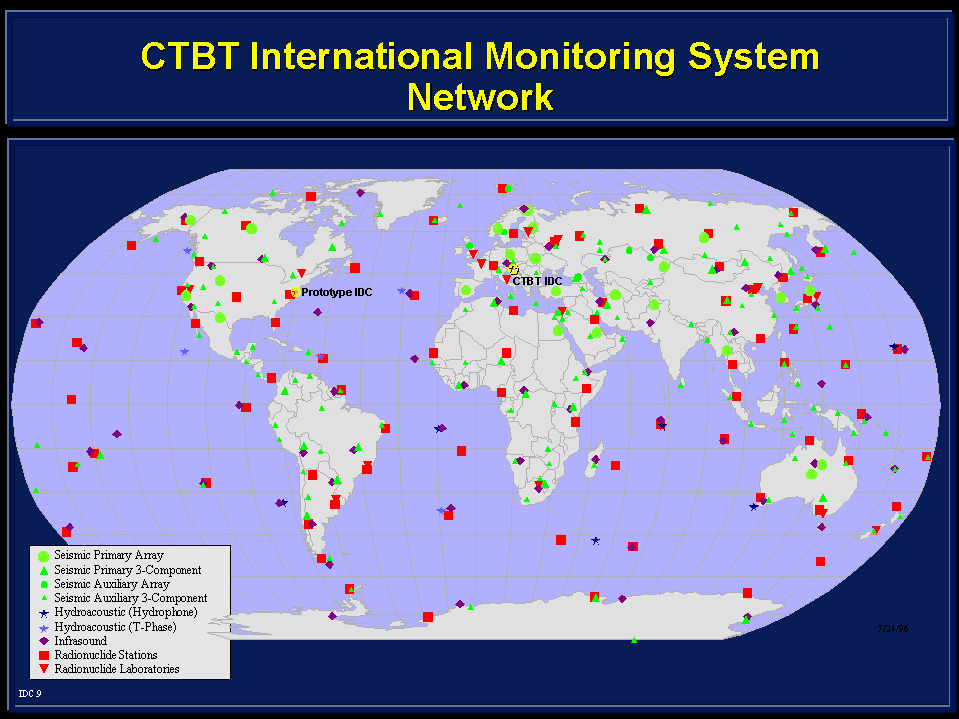
These are matters to be decided only at the highest levels of government, but experience shows the policy debate on nuclear testing has been and will likely continue to be influenced by developments in monitoring capability. The Atmospheric Test Ban of 1963 was intended in prior negotiations to be a comprehensive ban, failing that goal in part because of perceived inability at that time to monitor the underground environment. When the CTBT of 1996 eventually comes into force, an International Data Center (IDC) in Vienna will receive data from an International Monitoring System (IMS) that will negotiate the operation of 321 stations around the world (see Figure 1). A sophisticated global communications system is now being built to link the IMS stations to the IDC, where signals will be received in near real time and processed to provide basic information such as the locations of sources of various signals. A prototype international data center (PIDC) in Arlington, Virginia, sponsored by the U.S. Department of Defense, has already begun the work of CTBT monitoring, receiving data from global networks of hydroacoustic, infrasound and radionuclide sensors whose installation has barely begun. Seismology provides by far the most important data for routine CTBT monitoring, and data from about 75 of the eventual 170 seismographic stations of the IMS are now being sent by satellite links to the PIDC. These latter stations are essentially complete in several regions of the world, for example near the former nuclear test sites of the U.S. and Russia.
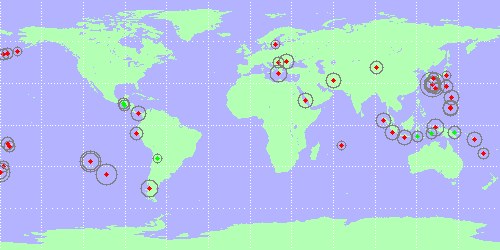 Figure 2. As an example of products now made available at
http://www.pidc.org, here is the map of 48 seismic events located by the
Prototype IDC for a recent 24 hour period, namely April 29, 1999. Shallow
and moderately deep events are red, very deep events are green.
Figure 2. As an example of products now made available at
http://www.pidc.org, here is the map of 48 seismic events located by the
Prototype IDC for a recent 24 hour period, namely April 29, 1999. Shallow
and moderately deep events are red, very deep events are green.
The PIDC now makes openly available at http://www.pidc.org an extensive series of products which indicate the practical problems of global monitoring, and how these problems may be solved. For example, Figure 2 shows the location as determined by the PIDC of 48 seismic events which occurred on April 29, 1999. About thirty of them on this day alone had signals large enough to correspond to an underground nuclear explosion of approximately a thousand tons of TNT equivalent, or larger. (A thousand tons is small for a nuclear weapon --- the Hiroshima bomb was about 15,000 tons.) Presumably most if not all of the 48 events that day are natural earthquakes. Perhaps some of these seismic events on April 29 were big mining blasts. But could any one of them have been a nuclear explosion?
Depending on one's political perspective, one might want to check the events on U.S. territory (three of them, all in the Aleutians), or events in the Indian Ocean and in far western China (see Fig. 2). For the latter event, a click on the PIDC web pages produces the map of Figure 3, showing the location in China at the center and also the 18 IMS stations which acquired seismic signals from this event, whose yield if nuclear would likely be very small --- somewhat less than a thousand tons of TNT. But 13 of these stations recorded seismic waves that were reflected at the Earth's surface above the source itself, enabling the PIDC to assign a depth estimate of 29 km with high confidence (uncertainty = ± 3.2 km). A seismic event at this depth could only be an earthquake.
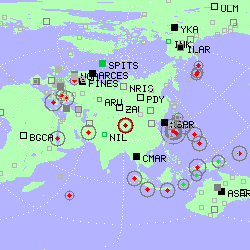 Figure 3. The small earthquake in far western China,
on April 29, 1999, is shown here at the center of the map
along with the location of IMS stations which detected
this particular seismic event, and with the other seismic
events reported that day.
Figure 3. The small earthquake in far western China,
on April 29, 1999, is shown here at the center of the map
along with the location of IMS stations which detected
this particular seismic event, and with the other seismic
events reported that day.
Could the event that day in the Indian Ocean be a nuclear explosion? Figure 4 indicates four IMS stations that acquired data; another three stations in North America also detected this very small event, whose yield, if it were nuclear, would be on the order of a hundred tons of TNT equivalent. The best way to tell if this was an earthquake or an explosion, would be to look at the hydroacoustic record for the IMS station on the island of Diego Garcia (a huge hydroacoustic signal would be expected at this location from any Indian Ocean explosion bigger than one ton in the water column) --- but that station is not yet installed. We can still have confidence that this is an earthquake and not an explosion, because the two seismographic stations in Africa (BOSA and BGCA) and the one in Thailand (CMAR) all recorded seismic surface waves --- which a small nuclear explosion would not generate. So in this case it is the mix of different seismic waves that enables discrimination, and the mix is characteristic of an earthquake.
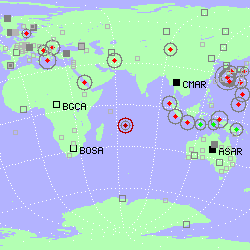 Figure 4. Another small earthquake on April 29, 1999,
this time in the Indian Ocean. It was detected in Thailand,
Africa, Australia and at three stations in North America.
Figure 4. Another small earthquake on April 29, 1999,
this time in the Indian Ocean. It was detected in Thailand,
Africa, Australia and at three stations in North America.
Since the PIDC began operations in 1995 it has documented several nuclear explosions: six by France and four by China, prior to their signing the CTBT in September 1996; and a series of nuclear tests by India and Pakistan in May 1998. Figure 5 shows the stations of the IMS that supplied 72 different seismic signals of the May 11, 1998, Indian nuclear test (announced as consisting of three near-simultaneous separate explosions). In this case, again, identification of the event as a nuclear test had to be done in the context of a seismically active background: there were 58 seismic events reported by the PIDC that day. This Indian event was easily identifiable as nuclear --- though not a treaty violation because India has not yet signed either the CTBT or the Non-Proliferation Treaty. (Whether India and Pakistan will sign the CTBT prior to its third anniversary continues to be debated and will likely be part of front page news stories later this year.)
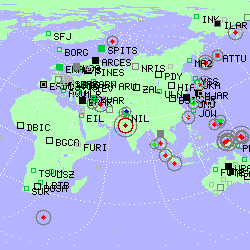 Figure 5. On May 11, 1998, India conducted a nuclear test
which generated 72 detectable seismic signals at
the IMS stations shown here --- on a day when there were
57 other seismic events requiring PIDC analysis. A station
at Nilore in Pakistan supplying data to the PIDC had a signal
from the Indian event whose amplitude was about a thousand
times above the noise level.
Figure 5. On May 11, 1998, India conducted a nuclear test
which generated 72 detectable seismic signals at
the IMS stations shown here --- on a day when there were
57 other seismic events requiring PIDC analysis. A station
at Nilore in Pakistan supplying data to the PIDC had a signal
from the Indian event whose amplitude was about a thousand
times above the noise level.
It is not the responsibility of the PIDC (or the IDC in Vienna) to determine whether detected events are explosions or earthquakes, but rather to provide data to treaty signatories for them to make their own determinations. For the CTBT verification system to be effective, it is therefore important that all the IMS stations be installed and operated to high standards; that data be received and analysed as planned by the IDC; and, in order to build confidence in the system, that the IMS data be readily available to interested parties. These data can also contribute in a major way to our scientific understanding of the Earth and our efforts to mitigate earthquake hazards, so it is important to take note of CTBT text stating that "The provisions of this Treaty shall not be interpreted as restricting the international exchange of data for scientific purposes." It is the U.S. position that all data from the International Monitoring System should be openly available without restriction or delay.
The U.S. contributes 25% of the funding needed by the IMS and IDC --- whose total cost may reach $200 million for installation of all stations and all IMS/IDC operations for the first few years. The work of the international verification system is made difficult by the active background of signals provided by planet Earth, but it is the consensus of experts that if IMS/IDC operations are funded and carried out as planned then CTBT monitoring can be done with high confidence down to low yields, as indicated by the examples discussed above. Numerous other seismographic stations, operated for reasons unrelated to treaty monitoring, may also supply high-quality data as needed to study particular events of interest.
The global monitoring network is international in scope because of the data contributions that will be required from the 89 or more countries on whose territory the IMS stations are to be located, because of the composition of the multi-national staff of the IDC in Vienna, and because of the international funding. But more fundamentally it is international because the seismic and other phenomena which the network is designed to detect and quantify arise as phenomena of planet Earth, which belongs to all countries and peoples, and which is itself the central subject of collaborative study by seismologists and other Earth scientists. By contributing to CTBT monitoring, seismology delivers on its promise as an important applied science, enabling key steps to be taken in nuclear arms control.
The above words were written, in 1999, prior to the decision on October 13 by the U.S. Senate not to give advice and consent to ratification of the CTBT.